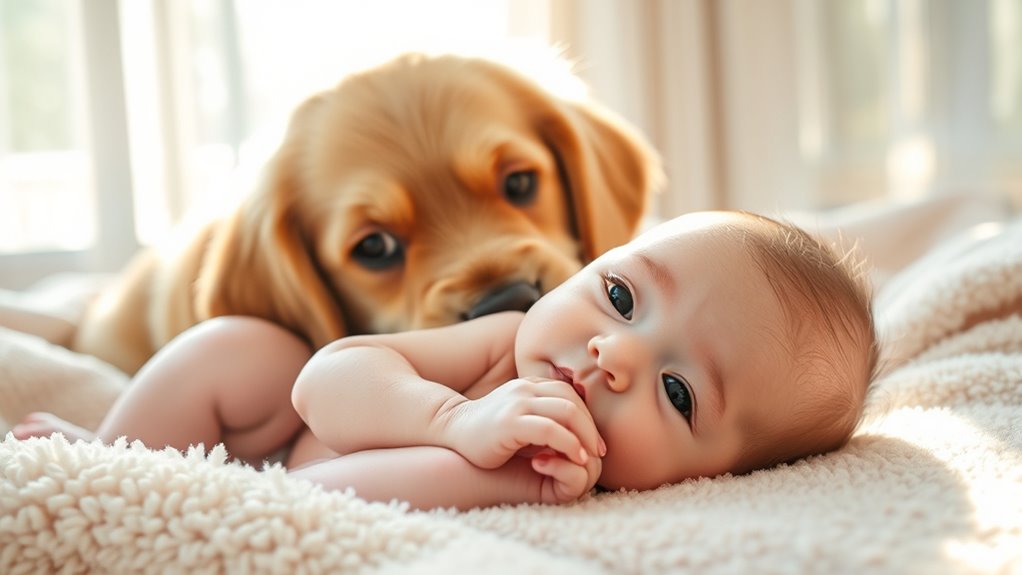To guarantee a safe, healthy bond between your pet and baby, start with consistent training before your little one arrives. Recognize your pet’s cues to prevent stress and make initial introductions calm and supervised. Baby-proof the environment and create a designated safe space for your pet. Patience and ongoing management are key. By taking these steps, you’ll foster trust and harmony—discover more tips to make the transition smoother for everyone involved.
Key Takeaways
- Train your pet with basic commands and boundaries before the baby arrives to promote safe interactions.
- Recognize and respond to your pet’s stress signals to prevent anxiety or aggressive behavior around the baby.
- Baby-proof the environment by securing cords, removing small objects, and creating a designated safe space for the pet.
- Introduce the pet to the baby gradually, keeping initial meetings calm and supervised, with positive reinforcement.
- Maintain consistent routines, patience, and a quiet space for your pet to help them adapt to the new family dynamic.

Introducing a new baby into your home can be an exciting yet delicate experience, especially when it involves your beloved pet. You want the *transition* to be smooth, safe, and positive for everyone. To achieve this, it’s essential to focus on pet training and baby proofing tips early on. Proper pet training helps your pet understand boundaries and reduces the risk of unwanted behaviors around the baby. For example, teaching your pet basic commands like “sit,” “stay,” and “leave it” can be invaluable. These commands give you control and help prevent your pet from jumping on the baby or grabbing toys. Consistent training before the baby arrives prepares your pet mentally and behaviorally, making the eventual introduction less stressful. Additionally, understanding pet behavior cues can help you recognize when your pet is feeling anxious or overwhelmed, facilitating smoother interactions. Baby proofing tips are equally important. Babies are naturally curious and tend to explore with their hands and mouths, which can lead to accidents. Start by securing electrical cords, covering outlets, and removing small objects that could be swallowed. Keep cleaning supplies, medications, and any sharp or toxic items out of your pet’s reach. If your pet has a favorite spot or toy that might pose a risk, consider adjusting their environment to keep everything safe. Additionally, create a designated space for your pet that’s quiet and comfortable, where they can retreat if overwhelmed or need a break from the new routines. When it’s time for the initial meeting, keep the introduction calm and controlled. Have someone hold the baby securely while you supervise your pet’s interaction. Let your pet sniff the baby gently, but don’t force the encounter. Use positive reinforcement, like treats and praise, to reward calm and gentle behavior. Remember, never leave your pet alone with the baby until you’re confident they can interact safely. This helps prevent accidental injuries and builds trust between your pet and your little one. Throughout the process, keep communication open and consistent. Reinforce pet training commands regularly, and maintain baby proofing measures as your baby grows and becomes more mobile. Patience is key; your pet may need time to adjust to the new family member. With careful planning, proper training, and thoughtful baby proofing tips, your pet can become a loving and safe companion for your baby, creating a bond built on trust and mutual respect. This approach ensures a harmonious environment where both your pet and your baby can thrive together.
Frequently Asked Questions
How Can I Prepare My Pet Before the Baby Arrives?
To prepare your pet before the baby arrives, start with pet training to reinforce good behavior and reduce anxiety. Make environmental adjustments by creating a dedicated, quiet space for your pet and gradually introducing baby-related items. Incorporate positive reinforcement to help your pet adapt comfortably. By planning ahead, you’ll ease your pet’s progression and foster a safe, loving bond between your pet and future family member.
What Signs Indicate My Pet Is Stressed Around the Baby?
You want to know how to spot stress signals or pet anxiety around your baby. Look for signs like excessive barking, hiding, or avoiding your baby, as well as changes in appetite or grooming habits. You might also notice aggressive behaviors or restlessness. These are clear indicators your pet feels overwhelmed or stressed. Recognizing these signs early helps you address pet anxiety and create a calmer environment for everyone.
Are There Specific Breeds More Suitable for Homes With Infants?
When choosing a pet for a home with an infant, breed compatibility and temperament considerations are key. Some breeds tend to be more gentle, tolerant, and adaptable around children, making them better suited for families. You should look for breeds known for their calm demeanor and patience. Research each breed’s typical behavior, and spend time with the pet beforehand to guarantee a good fit, creating a safe and happy environment for your baby and pet.
How Should I Introduce My Pet to the Baby’s Nursery?
Start with a soft, safe scent introduction by placing your pet’s blanket or toy in the nursery, allowing them to familiarize themselves with the space gradually. Follow nursery safety tips by keeping the area secure and free of hazards. When ready, supervise your pet’s first sniff and interaction, ensuring they’re calm and comfortable. This gentle process helps your pet bond with the baby’s space without any stress or surprises.
What Are Common Behavioral Changes in Pets After a Baby’s Arrival?
When your baby arrives, you might notice behavioral changes in your pet like increased clinginess, hiding, or even aggression. These reactions are common and can be managed through pet training and behavioral modification. You should observe your pet’s behavior closely, provide extra attention, and maintain routines. If needed, consult a veterinarian or animal behaviorist to help your pet adapt smoothly and ensure a positive bond with your new family member.
Conclusion
As you watch your pet and baby grow closer, remember they’re building a bond like a delicate garden—requiring patience, care, and understanding. I once saw a puppy gently nuzzle a newborn, turning a cautious moment into a lifelong friendship. With a little effort, you create a safe space where trust blossoms naturally. Keep supervising, set boundaries, and nurture their relationship—soon, you’ll see a beautiful, resilient friendship that enriches both their lives.










